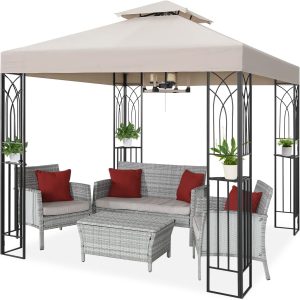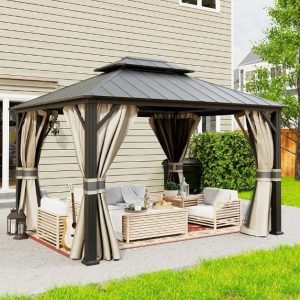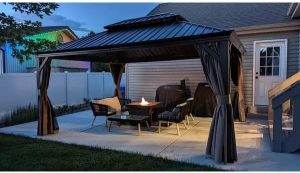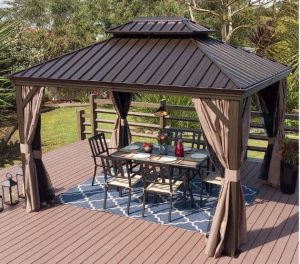When it comes to creating an outdoor space that offers shelter and protection from the elements, a gazebo is a popular choice.
Gazebos come in many different styles, sizes, and materials, but one of the most important decisions you’ll need to make is whether to go with a soft or hard top gazebo.
While both options have their pros and cons, many people wonder if one is more affordable than the other.
Soft top gazebos are typically made of fabric or other flexible materials, which can make them less expensive than hard top gazebos.
They’re also often easier to set up and take down, making them a convenient option for events and parties. On the other hand, hard top gazebos are made of durable materials like metal or wood, which can make them more expensive, but also more sturdy and long-lasting.
In this article, we’ll take a closer look at the differences between soft top and hard top gazebos, and explore the factors that can impact the cost of each option.
Ultimately, the decision will come down to your budget, preferences, and intended use for your gazebo.
Are soft top gazebos more affordable than hard-top gazebos?: Soft-top gazebos are generally more affordable than hard-top gazebos due to the materials used and the more straightforward construction process. However, the cost can vary depending on the size, materials, and features. It’s recommended to compare prices and features before making a decision.
Are soft top gazebos more affordable than hard top gazebos? Easy Guide
Are you wondering if soft top gazebos are cheaper than hard-top gazebos? Generally, soft-top gazebos are more affordable than hard top gazebos. The main reason for this price difference is that soft top gazebos use less expensive materials than those used in hard top gazebos.
Soft top gazebos are typically made with a fabric or mesh roof and poles made of aluminum or steel.
In contrast, hard-top gazebos have a solid roof made of materials like wood, metal, or plastic. This makes them sturdier and more durable but also more expensive.
Ultimately, the choice between a soft top or hard top gazebo depends on your budget and specific needs.
Soft Top Gazebos

Soft top gazebos are a popular option for outdoor living spaces, offering shade and protection from the sun and rain.
These gazebos feature a fabric or vinyl canopy that is stretched over a metal frame, creating a sheltered space that is perfect for entertaining, relaxing, or dining.
We’ll take a closer look at soft top gazebos, including their definition and description, the materials used in their construction, their advantages and disadvantages, and their price range.
Definition of Soft Top Gazebos
A soft-top gazebo is a type of outdoor structure that is designed to provide shade and protection from the elements. These gazebos are typically made with a lightweight metal frame that is covered with a fabric or vinyl canopy.
The canopy is stretched over the frame and secured in place, creating a sheltered area that can be used for a variety of outdoor activities.
Soft top gazebos come in a variety of sizes and shapes, from small, simple models that are perfect for a backyard barbecue to larger, more elaborate designs that are suitable for weddings, parties, or other events.
They are typically easy to assemble and disassemble, making them a popular option for temporary outdoor structures.
Materials Used in Soft Top Gazebos
Soft top gazebos are typically made with a lightweight metal frame that is designed to be easy to assemble and disassemble.
The frame may be made with aluminum, steel, or another lightweight metal that is strong enough to support the canopy but light enough to be easily transported.
The canopy of a soft top gazebo is typically made with a synthetic fabric or vinyl material that is designed to be lightweight, waterproof, and durable.
Common materials used in the construction of soft-top gazebo canopies include polyester, nylon, and PVC.
The canopy is stretched over the frame and secured using hooks, loops, or other fasteners.
Advantages and Disadvantages of Soft Top Gazebos

Soft top gazebos offer several advantages over other types of outdoor structures, including:
Affordability: Soft top gazebos are generally less expensive than hard top gazebos or other permanent outdoor structures.
Portability: Soft top gazebos are easy to assemble and disassemble, making them a popular option for temporary outdoor structures.
Versatility: Soft top gazebos come in various sizes and shapes, making them suitable for a wide range of outdoor activities.
Aesthetics: Soft top gazebos come in various colors and patterns, making them a popular option for adding a pop of color and personality to your outdoor space.
Disadvantages
However, soft top gazebos also have some disadvantages to consider, including:
Durability: Soft top gazebos are typically less durable than hard top gazebos or other permanent outdoor structures. The canopy material may be susceptible to damage from prolonged exposure to the sun or inclement weather.
Maintenance: Soft top gazebos may require more maintenance than hard top gazebos, including regular cleaning and possible replacement of the canopy or frame components.
Weather Resistance: Soft top gazebos may not be suitable for harsh weather conditions, including heavy snow or strong winds.
Price Range of Soft Top Gazebos
The price range of soft top gazebos varies widely depending on the size, materials, and features of the gazebo. Basic models may cost as little as $100, while larger, more elaborate models can cost several thousand dollars.
On average, a good quality soft top gazebo will cost between $300 and $1,500. Factors that can affect the price include the size of the pavilion, the materials used in the construction, the quality of the canopy fabric, and the features included, such as mosquito netting or curtains.
When shopping for a soft top gazebo, it’s essential to consider your budget and your specific needs. A lower-priced model may be sufficient if you’re looking for a simple, temporary structure for occasional use.
However, investing in a higher-quality model may be worth the extra expense if you plan to use your gazebo frequently or for special events.
Choosing a soft top gazebo that is well-constructed and made with quality materials is essential. Look for a sturdy and stable frame with a canopy fabric that is durable and resistant to fading, tearing, and other forms of damage.
Consider features such as mosquito netting, curtains, or other accessories that can enhance the functionality and comfort of your gazebo.
Hard Top Gazebos

A gazebo is a popular outdoor structure that offers shade, shelter and a comfortable place to relax and enjoy the outdoors.
Hard-top gazebos are a specific type of gazebo that offers a more permanent and sturdy structure than their soft-top counterparts.
In this article, we’ll define and describe hard-top gazebos, explore the materials used in their construction, discuss their advantages and disadvantages, and provide a price range for these structures.
Definition of Hard Top Gazebos
A hard-top gazebo is a permanent outdoor structure typically featuring a solid, rigid, durable metal or wood roof.
Unlike soft-top gazebos, which often have a fabric or flexible roof that can be removed or adjusted, hard-top pavilions are built to last and are intended for year-round use.
These structures are often used for outdoor entertaining, dining, or as a space for relaxation and recreation.
Materials Used in Hard Top Gazebos
The materials used to construct hard top gazebos can vary depending on the manufacturer and the specific model. However, the most common materials used in hard top gazebos include metal, wood, and composite materials.
Metal hard top gazebos are typically made of aluminum or steel. These materials offer excellent durability and resistance to weather, rust, and corrosion.
They also require minimal maintenance and are relatively lightweight, which makes them easy to transport and install.
Wooden hard top gazebos are often made of cedar or weather-resistant wood. These structures have a natural, rustic look that can add warmth and charm to any outdoor space.
However, wood gazebos require regular maintenance to keep them in good condition, such as staining or sealing the wood to prevent rot, insect damage, or water damage.
Composite hard top gazebos are made of a combination of wood and plastic materials. This type of gazebo offers metal gazebos’ durability and weather resistance, with the natural look and feel of wood.
Composite gazebos require minimal maintenance and are a popular option for homeowners who want the look of wood without the upkeep.
Advantages and Disadvantages of Hard Top Gazebos

Hard top gazebos offer several advantages over soft top gazebos, including durability, year-round use, and the ability to withstand harsh weather conditions.
However, they also have some disadvantages that are important to consider before making a purchase.
Advantages of Hard Top Gazebos:
Durability: Hard top gazebos are built to last and offer excellent resistance to weather, insects, and other outdoor hazards.
They’re made of durable materials that can withstand heavy use, which makes them a good investment for homeowners who want a long-term outdoor structure.
Year-round use: Unlike soft top gazebos, which may need to be taken down during the winter or inclement weather, hard top pavilions are built to withstand harsh conditions year-round.
They provide a reliable shelter for outdoor activities and can be used for outdoor entertaining, dining, or relaxation, no matter the season.
Aesthetics: Hard top gazebos often have a more substantial and polished appearance than soft top gazebos. They can add elegance and style to any outdoor space and provide a focal point for landscaping and other outdoor features.
Disadvantages of Hard Top Gazebos
Cost: Hard top gazebos are often more expensive than soft top gazebos. The materials used in their construction are typically more expensive, and the installation process may be more involved.
Installation: Installing a hard top gazebo can be more challenging than a soft top gazebo. These structures are often heavier and require a more significant foundation, which can add time and expense to the installation process.
Maintenance:
Maintaining a hard top gazebo can also be more time-consuming than maintaining a soft top gazebo. Wooden gazebos, in particular, require regular staining or sealing to prevent rot, warping, and other damage caused by exposure to the elements.
Metal gazebos may also require occasional cleaning and touch-up painting to maintain their appearance.
Price Range of Hard Top Gazebos

The price of a hard top gazebo can vary widely depending on several factors, including the materials used, the size of the structure, and the manufacturer.
In general, hard-top gazebos are more expensive than soft top gazebos but offer a more durable and long-lasting outdoor structure.
On the lower end of the price range, a small metal hard top gazebo measuring around 8 feet by 8 feet can cost between $500 and $1,000.
These structures are often lightweight and may not have as many features as larger or more expensive models. Mid-range hard top gazebos can cost between $1,000 and $3,000, depending on the size and materials used.
These structures may have more elaborate designs, features, and additional accessories like mosquito netting or built-in lighting.
On the higher end of the price range, larger hard top gazebos made of high-quality materials like cedar or composite can cost upwards of $5,000 or more.
These structures may have additional features like built-in seating, outdoor kitchens, or custom finishes.
Comparison of Prices
Regarding the price of pavilions, there are many factors to consider, including the size, materials used, design features, and overall durability.
Both soft top and hard top gazebos come in various prices, and the cost can vary depending on several factors. Comparison of Prices of Soft Top and Hard Top Gazebos in Various Sizes and Materials
Soft top gazebos are generally less expensive than hard top gazebos, with prices starting as low as $100 for a small, basic model.
Soft top gazebos can be made of various materials, including canvas, polyester, and vinyl, and prices can vary depending on the quality and thickness of the fabric.
Mid-range soft top gazebos can cost between $200 and $1,000, depending on the size and features. These structures may have more elaborate designs, additional features like mosquito netting or curtains, and stronger, more durable fabric.
On the higher end of the price range, larger and more elaborate soft-top gazebos can cost upwards of $1,000 or more. These structures may have built-in seating, outdoor kitchens, or custom finishes.
Hard top gazebos are generally more expensive than soft-top gazebos, with prices starting at around $500 for a small metal model. Mid-range hard-top gazebos can cost between $1,000 and $3,000, depending on the size and materials used.
On the higher end of the price range, larger hard top gazebos made of high-quality materials like cedar or composite can cost upwards of $5,000 or more.
Factors That Affect the Price of Gazebos
Several factors can affect the price of gazebos, including:
Size: Larger gazebos are generally more expensive than smaller gazebos, as they require more materials and labor to construct.
Materials: The materials used in the construction of a gazebo can significantly affect the price. Soft top gazebos made of higher quality materials, such as thicker or more durable fabrics, can cost more than those made of cheaper materials.
Hard top gazebos made of wood or composite materials are generally more expensive than metal ones.
Design features: Additional design features like built-in seating, outdoor kitchens, or custom finishes can add to the overall cost of a gazebo.
Brand and manufacturer: The brand and manufacturer of a gazebo can also affect the price, as some companies may charge more for their products based on their reputation or quality. Analysis of the Price Difference Between Soft Top and Hard Top Gazebos
Overall, hard top gazebos are more expensive than soft-top gazebos, with prices ranging from several hundred to several thousand dollars more.
However, hard-top gazebos are generally more durable and long-lasting than soft-top gazebos, and they can provide year-round protection from the elements.
When deciding between a soft top and a hard top gazebo, it’s important to consider factors like budget, materials, and design features.
While a soft top gazebo may be a more affordable option for those on a tight budget, a hard top gazebo may be a better long-term investment for those who want a more durable and long-lasting outdoor structure.
Factors to Consider

When choosing between a soft top and a hard top gazebo, there are other factors beyond affordability.
These include maintenance and durability, aesthetic appeal and customization options, weather resistance and suitability for different climates. Let’s take a closer look at each of these factors.
Maintenance and Durability
One of the most significant differences between soft-top and hard-top gazebos is their durability. Hard top gazebos are typically made of more substantial materials such as wood, metal, or polycarbonate, which can withstand harsh weather conditions and last many years.
They require less maintenance than soft top gazebos, which may need to be repaired or replaced more frequently due to wear and tear.
Soft top gazebos are made of synthetic materials that can be susceptible to damage from exposure to the elements.
They may also require more maintenance than hard-top gazebos, including regular cleaning and possibly replacing the canopy or frame components.
Aesthetic Appeal and Customization
Both soft top and hard top gazebos come in a variety of styles and designs, making them customizable to fit your aesthetic preferences.
However, there are some differences to consider. Soft top gazebos are typically available in a wider range of colours and patterns, which can add a pop of colour and personality to your outdoor space.
Hard-top gazebos, on the other hand, may have a more classic and elegant look that can add sophistication and value to your home.
Additionally, hard-top gazebos may offer more customization options, such as built-in lighting or heating systems, built-in benches or seating, or even custom architectural features.
Soft top gazebos are more limited in terms of customization options, but they can still be personalized by adding curtains, lighting, or other accessories.
Weather Resistance and Suitability for Different Climates
Regarding weather resistance, hard-top gazebos are typically more suitable for harsh climates, including areas with heavy snow, strong winds, or frequent rain.
The sturdy materials used in hard-top gazebos can withstand extreme weather conditions better than soft-top gazebos.
Soft-top gazebos are more suitable for mild climates or areas with occasional rain or wind. The lightweight materials used in soft-top pavilions may not withstand heavy snow or wind, and the canopy material may be prone to damage from prolonged exposure to the sun.
It’s essential to consider the climate in your area when choosing a gazebo and to select a model suitable for the weather conditions you may encounter.
Related Article: Hardtop Vs Soft-top Gazebo
FAQs
Q.1 What materials are used in soft top gazebos?
Soft top gazebos are typically made with lightweight metal frames, such as aluminum or steel, and a fabric canopy, often made of polyester or another synthetic material.
Q.2 Do soft top gazebos require more maintenance than hard top gazebos?
Soft top gazebos may require more maintenance than hard top gazebos due to the fabric canopy, which may need to be cleaned or replaced over time. However, the maintenance required will depend on the quality of the materials used and how often the gazebo is used.
Q.3 Are soft top gazebos less durable than hard top gazebos?
Soft top gazebos are generally less durable than hard top gazebos due to the materials used in their construction. However, the level of durability will depend on the quality of the materials used and how well the gazebo is cared for.
Q.4 Can soft top gazebos withstand different weather conditions?
Soft top gazebos may not be as weather-resistant as hard top gazebos and may be more prone to wind, rain, and snow damage. However, some soft top pavilions are designed with weather-resistant materials and features such as water-resistant canopies and sturdy frames to withstand different weather conditions.
Q.5 What is the price range for soft top gazebos?
The price range for soft top gazebos can vary widely, depending on size, materials used, and included features. On average, soft top gazebos can range from $100 to $1000 or more.
Conclusion
In conclusion, soft top gazebos are generally more affordable than hard top gazebos due to the materials used in their construction.
Soft top gazebos typically use materials such as fabric or mesh for the roof and aluminum or steel for the poles, while hard top gazebos have a solid wood, metal, or plastic roof.
Soft top gazebos are cheaper, but hard top gazebos are sturdier and more durable.
The choice between a soft top or hard top gazebo ultimately depends on your budget and specific needs. Factors that affect the price of gazebos include the materials used, size, design, and brand.
When considering purchasing a gazebo, it’s important to consider factors such as maintenance, durability, weather resistance, and your budget and desired features.
We hope this guide has helped you understand whether soft top gazebos are cheaper than hard top gazebos. If you have any questions, please feel free to ask in the comments section below!

